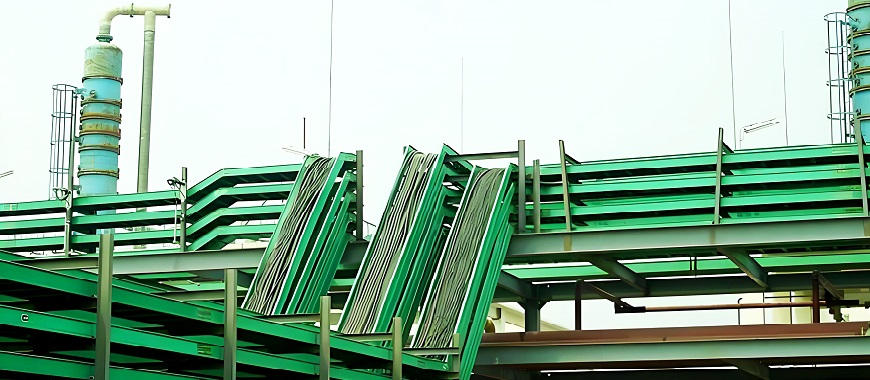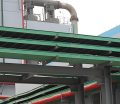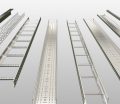
A cable tray sleeve is a vital component in modern cable management systems. It is designed to provide a safe and organized pathway for cables passing through walls or floors. This solution ensures cables remain protected, reducing the risk of damage from external elements or structural movement.Cable tray sleeves are essential for maintaining the integrity of electrical and communication systems. They help prevent tangling and clutter, making maintenance and troubleshooting more efficient. Additionally, these sleeves improve safety by minimizing the chances of fire hazards or cable wear.Widely used in residential, commercial, and industrial applications, cable tray sleeves offer a practical and reliable way to enhance cable management while maintaining a neat and professional appearance.
Types of Cable Tray Sleeves
Cable tray sleeves are essential components in cable management systems, offering solutions for safely routing and protecting cables. These sleeves come in different types, each suited for specific applications and environments. Below, we explore the common types of cable tray sleeves, highlighting their unique properties and use cases.
Cable Sleeve Plastic Options
Plastic cable sleeves are among the most popular choices due to their durability and lightweight construction. They are designed to meet a variety of needs, making them versatile solutions for both indoor and outdoor environments.
- Durable, Lightweight Solutions for Indoor and Outdoor Use
Plastic cable sleeves are made from robust materials like PVC or polyethylene, providing excellent protection without adding excessive weight. This makes them ideal for environments where frequent handling or adjustments are required. Plastic sleeves are resistant to moisture, corrosion, and UV radiation, making them suitable for outdoor installations as well.Advantages include:- Long-lasting performance in humid or corrosive environments.
- Easy installation due to their lightweight nature.
- Cost-effective for large-scale installations.
- Applications in Various Environments Requiring Lightweight Cable Protection
Plastic cable sleeves are widely used in residential, commercial, and light industrial settings. They are perfect for protecting cables in HVAC systems, outdoor lighting, and temporary installations where mobility is crucial.
Electrical Cable Sleeve Solutions
Electrical cable sleeves are specialized solutions designed to enhance safety and durability in installations involving electrical wiring. They provide robust protection against physical damage and environmental stressors, ensuring long-term reliability.
- Specially Designed for Electrical Installations to Ensure Safety
Electrical cable sleeves are often reinforced to withstand harsh conditions, including mechanical stress, abrasion, and temperature fluctuations. Their design prioritizes insulation to minimize the risk of short circuits and electrical failures.Benefits include:- Enhanced electrical safety through superior insulation.
- Reduced risk of fire and electrical hazards.
- Compliance with safety regulations for sensitive installations.
- Fire-Resistant Properties and Enhanced Durability for Industrial Applications
Many electrical cable sleeves are manufactured with fire-resistant materials to meet the demands of industrial applications. These sleeves can withstand extreme temperatures and provide a protective barrier in high-risk environments such as power plants and chemical facilities.
Cable Management Sleeve White Variants
For home and office environments, aesthetics play a significant role in cable management. White cable management sleeves are specifically designed to blend seamlessly with interior décor while providing effective cable organization.
- Aesthetic Options for Home or Office Setups
White cable sleeves are perfect for maintaining a clean and professional appearance in modern spaces. They offer a neat solution for organizing cables in open areas without detracting from the room’s design.Advantages include:- Enhancing the visual appeal of cable installations.
- Reducing clutter and improving workspace organization.
- Suitable for desks, entertainment centers, and conference rooms.
- Perfect for Blending with Interiors While Organizing Cables Effectively
These sleeves are available in various sizes to accommodate different cable bundles, ensuring flexibility and ease of use. Their neutral color helps them blend with walls, baseboards, or ceilings effortlessly.
Top Materials for High Voltage Cable Tray Applications
Installation and Usage of Cable Tray Sleeves
Proper installation of cable tray sleeves is crucial for ensuring their effectiveness and longevity. Below, we detail the installation process and the hardware requirements for securing cable tray sleeves in place.
Step-by-Step Installation Process
Installing cable tray sleeves requires attention to detail to ensure a secure and professional finish. Here’s how it’s done:
- Preparing the Wall or Floor for Sleeve Placement
- Begin by marking the area where the sleeve will be installed.
- Cut an appropriately sized opening to accommodate the sleeve securely.
- Clean the surface to remove debris or uneven edges.
- Installing and Securing the Sleeve for a Professional Finish
- Insert the cable tray sleeve into the opening and align it properly.
- Use mounting brackets or collars to hold the sleeve in place.
- Seal any gaps around the sleeve to prevent dust or moisture ingress.
Common Hardware Requirements
To ensure a sturdy installation, specific hardware is required. Choosing compatible hardware is critical for the long-term stability of cable tray sleeves.
- Types of Hardware Typically Used for Mounting Cable Tray Sleeves
- Mounting brackets or clamps for securing sleeves to walls or floors.
- Fasteners such as screws or bolts compatible with the sleeve material.
- Sealing rings to provide a snug fit and prevent movement.
- Ensuring Compatibility with Wall or Floor Materials
- Consider the material of the wall or floor, whether concrete, drywall, or wood.
- Use anchors or expansion bolts for installations on concrete or masonry.
- Opt for self-tapping screws for easier installation on wooden surfaces.
Intumescent Cable Tray Sleeve for Fire Stopping
Fire safety is a critical consideration in cable management. Intumescent cable tray sleeves are specifically designed to prevent the spread of fire through cable penetrations, offering a crucial layer of protection in buildings.
Importance of Fire Safety in Cable Management
Intumescent cable tray sleeves play a vital role in ensuring safety by minimizing fire risks. They are engineered to expand when exposed to high temperatures, effectively sealing cable openings and preventing the spread of flames and smoke.
Detailed Explanation of Intumescent Cable Tray Sleeve Properties
- Swelling in High Temperatures to Seal Cable Penetrations
Intumescent sleeves are coated with materials that expand and harden under heat, creating an airtight seal around cables. This feature is particularly important in fire-rated walls or floors, where maintaining the integrity of fire barriers is essential.Key benefits include:- Protection against the spread of fire and toxic smoke.
- Compliance with fire safety standards and building codes.
- Enhanced safety for occupants and equipment.
- Applications in Commercial and Industrial Buildings
These sleeves are widely used in data centers, manufacturing facilities, and office complexes, where high-density cabling increases fire risks. By installing intumescent cable tray sleeves, businesses can ensure regulatory compliance while safeguarding assets and personnel.
Installation Tips and Regulatory Compliance Considerations
- Install sleeves following manufacturer instructions to ensure optimal performance.
- Use approved fire-stopping sealants to enhance the effectiveness of the sleeve.
- Regularly inspect and maintain fire-stopping systems to meet compliance standards.
Enhancing Safety and Efficiency with Cable Tray Sleeves
Cable tray sleeves are indispensable in modern cable management, offering solutions for safety, organization, and fire protection. By understanding the types, applications, and installation methods, you can choose the right cable tray sleeve to meet your needs. Whether for residential, commercial, or industrial use, these components ensure cables are well-protected, reducing risks and improving system reliability. For the best results, consider GangLong Fiberglass products known for their durability and compliance with industry standards.
Improving Safety with a Walkable Checkerboard Cable Tray Cover
Applications of Cable Tray Fire Stopping Systems
Cable tray fire stopping systems are essential in maintaining the safety and integrity of buildings. These systems prevent fire from spreading through cable penetrations, ensuring the safety of occupants and critical equipment. Below are the key ways these systems are used in various environments.
Preventing the Spread of Fire Through Cable Penetrations
Cable tray fire stopping systems are specifically designed to contain fires at their source. This is achieved through fire-resistant materials that seal gaps around cables.
- How Fire Stopping Systems Work
These cable tray sleeves, coatings, or intumescent materials that expand when exposed to high temperatures. This expansion blocks flames, smoke, and toxic gases from traveling through cable openings. - Key Benefits of Preventing Fire Spread
- Protects Life and Property: Fire stopping systems save lives and reduce property damage by isolating the fire.
- Maintains Structural Integrity: By containing fires, these systems help preserve the strength of walls and floors.
- Ensures Regulatory Compliance: Most building codes require fire stopping solutions for cable penetrations.
- Reduces Business Downtime: Limiting fire damage ensures quicker recovery and less disruption to operations.
- Supports Insurance Claims: Proper fire-stopping measures can streamline claims in case of a fire-related incident.
Enhancing Safety in Residential, Commercial, and Industrial Settings
Cable tray fire stopping systems are vital across different sectors, from homes to large industrial facilities.
- Residential Applications
In homes, fire stopping systems safeguard electrical systems, especially in areas like attics or basements where cable penetrations are common. These solutions prevent small fires from spreading to other parts of the house, offering peace of mind to homeowners. - Commercial Applications
Office buildings, retail stores, and data centers use these systems to protect high-value equipment and prevent catastrophic data losses. In these settings, fire stopping solutions must be integrated with existing cable management systems to comply with local regulations. - Industrial Applications
Factories, refineries, and warehouses rely on fire stopping systems to manage high-density cabling in harsh environments. These systems ensure safety in areas where electrical fires pose a significant risk due to volatile materials or heavy machinery.
The Role of an Embedded Cable Tray in Concealed Designs
Choosing the Right Cable Tray Sleeve for Your Needs
Selecting the right cable tray sleeve is critical for ensuring safety, efficiency, and durability. Below are the key factors to consider when making a choice.
Key Factors to Consider
When choosing a cable tray sleeve, understanding the specific requirements of your project is essential.
- Material Selection
Different materials, such as plastic, metal, or fire-resistant composites, offer varying levels of durability and functionality. For instance, plastic sleeves are lightweight and affordable, while metal sleeves provide greater strength and resistance to wear. - Fire Resistance
In environments prone to fire hazards, choosing a fire-resistant sleeve is non-negotiable. Intumescent cable tray sleeves are an excellent option for preventing the spread of fire through cable penetrations. - Application Environment
Consider the location where the sleeve will be installed. Outdoor environments may require UV-resistant materials, while high-temperature areas demand heat-resistant options. - Cable Capacity
Ensure the sleeve can accommodate the number and type of cables you plan to route. Overloading a sleeve can compromise its performance. - Regulatory Compliance
Verify that the chosen sleeve meets local safety standards and building codes. This ensures legal compliance and enhances safety.
Enhancing Safety and Organization with Cable Tray Sleeves
Cable tray sleeves are indispensable for modern cable management, providing solutions that enhance safety, organization, and efficiency. They are critical in preventing fire spread, maintaining aesthetic appeal, and protecting cables in various environments.
By choosing the right cable tray sleeve, tailored to your project’s needs, you can ensure reliable performance and long-term safety. Whether for residential, commercial, or industrial applications, these sleeves deliver unmatched value by safeguarding cables and optimizing management systems.
For top-quality solutions, products like those from GangLong Fiberglass stand out for their durability and compliance with industry standards. Investing in the right sleeve not only enhances safety but also ensures a professional and organized installation.
FAQs about Cable Tray Sleeve
Cable sleeves are used to organize, protect, and route cables in various installations. They provide a clean and safe pathway for cables, reducing clutter and preventing damage. These sleeves are essential in environments where cables are exposed to physical wear, moisture, or environmental stress. They also improve the aesthetic appeal of spaces by concealing unsightly cables. In industrial settings, cable sleeves safeguard electrical and communication lines from abrasion and chemical exposure. Additionally, they simplify maintenance by allowing technicians to identify and access specific cables easily. Cable sleeves are versatile and used in residential, commercial, and industrial applications to ensure efficient cable management.
A cable tray cover is designed to provide additional protection for cables housed within a cable tray. Its primary purpose is to shield cables from external elements such as dust, moisture, and mechanical impact. Covers also enhance the safety of cable installations by preventing accidental contact with live wires. In outdoor or industrial settings, cable tray covers protect against UV radiation, corrosion, and chemical spills. By enclosing the cables, they help maintain a clean and organized appearance, particularly in visible areas. Cable tray covers are an essential component for ensuring long-term durability and reliability in any cable management system.
The best material for a cable sleeve depends on the specific application and environment. Plastic materials like PVC or polyethylene are lightweight, durable, and cost-effective, making them ideal for general-purpose use. For industrial environments, metal sleeves, such as those made from aluminum or steel, offer superior strength and resistance to high temperatures and abrasion. Fire-resistant materials, including intumescent coatings, are recommended for areas requiring enhanced safety measures. Flexible materials like neoprene or braided nylon are excellent for accommodating cable movement and providing insulation. Each material has unique advantages, so selecting the right one depends on factors like temperature, exposure to chemicals, and the type of cables being managed.
Cable trunking and cable trays serve distinct purposes in cable management. Cable trunking is a fully enclosed system designed to conceal and protect cables. It is commonly used in offices or residential spaces to maintain a tidy appearance. Trunking provides superior protection against dust, moisture, and accidental damage, making it suitable for small-scale or aesthetic applications. In contrast, cable trays are open systems used to support large volumes of cables, particularly in industrial and commercial environments. They allow for better ventilation, reducing the risk of overheating in high-capacity installations. Cable trays are ideal for installations requiring frequent access to cables or additional flexibility for future expansions. Both systems are valuable tools in cable management, with the choice depending on the project’s requirements.

As the editor of GangLong Fiberglass, I have years of experience and in-depth research, focusing on cable tray products, fiberglass solutions, and grille systems. I incorporate years of industry insights and practical experience into every content, committed to promoting the progress of the industry. At GangLong Fiberglass, my commitment is reflected in every product, from innovative cable trays to durable fiberglass solutions and sturdy grille systems. As an authoritative voice in the industry, my goal is to provide valuable information to professionals and businesses and promote forward-looking solutions.


